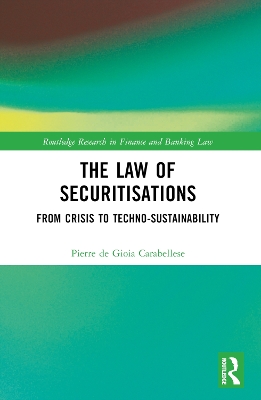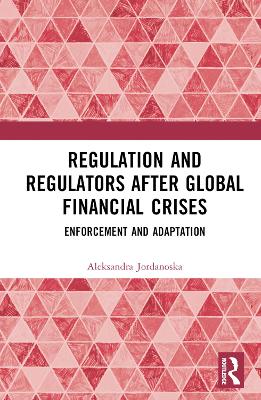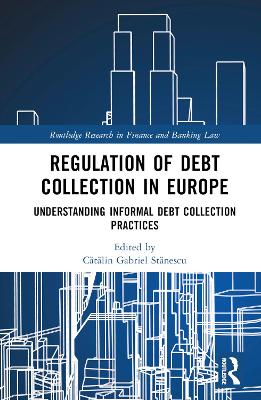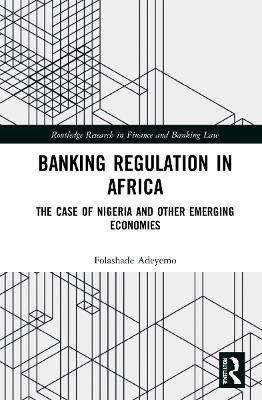Regulation of Megabanks
 portes grátis
portes grátis
Regulation of Megabanks
Legal frameworks of the USA and EU
Parchimowicz, Katarzyna
Taylor & Francis Ltd
11/2022
232
Dura
Inglês
9781032233475
15 a 20 dias
Descrição não disponível.
Contents
ACKNOWLEDGMENTS
LIST OF ABBREVIATIONS
INTRODUCTION
Context and rationale
Structure
Methodology and terminology
Limitations
Place in existing literature
Chapter 1. G-SIBs IN THE USA AND IN THE EU - DIVERSITY, NOT UNITY
1.1. GENERAL SHIFT FROM TRADITIONAL BANKING BUSINESS
1.1.1. Traditional banking and change-driving forces
1.1.1.1. Capital and ideological flows that globalized banking
1.1.1.2. Information technology and financial innovations
1.1.1.3. Political and regulatory adjustments
1.1.2. Modern activities of banks
1.1.3. Modern ways of funding
1.1.4. Risks of modern banking
1.1.5. Modern banking business models
1.2. RISE OF THE G-SIBS - DIFFERENCES AT THE OUTSET
1.2.1. Combining and expanding
1.2.2. Growth
1.2.3. Internationalization
1.3. G-SIBS AS AN UN-UNIFORM GROUP - DIFFERENCES NOW
1.3.1. An un-uniform group
1.3.1.1. Activities
1.3.1.2. Funding
1.3.1.3. Risks
1.3.1.4. Legal structure
1.3.1.5. Ownership
1.3.2. Attempts at business model classification
1.4. CHALLENGES AND OPPORTUNITIES FACING G-SIBs - DIFFERENCES IN THE FUTURE?
1.4.1. Big Tech
1.4.2. Green revolution
1.4.3. COVID-19
1.5. SUMMARY
Chapter 2. G-SIBS AND THE GLOBAL FINANCIAL CRISIS
2.1. REGULATION BEFORE THE GFC: REGULATORY LOOPHOLES AND GENERALIZATION
2.1.1. Non-existent regulation
2.1.2. Overly general regulation
2.1.3. Lack of supervisory discretion
2.2. G-SIBS' ADJUSTMENTS TO THE GENERAL RULES
2.2.1. Size of assets
2.2.2. Leverage
2.2.3. Capital, losses and raising capital
2.2.4. Funding patterns, liquidity and resolution
2.2.4.1. Liquidity problems and resolution
2.2.4.2. Liquidity supplementation
2.2.5. Securitization
2.2.5.1. Origination
2.2.5.2. Underwriting
2.2.6. Contagion
2.3. AUTHORITIES AWAKEN
2.3.1. Ad-hoc help
2.3.2. G-SIBs' redemption
2.3.3. Regulatory resolutions
2.4. SUMMARY
Chapter 3. REGULATION OF G-SIBS IN THE USA AND THE EU - OVERLY GENERAL, BUT FIXABLE?
3.1. INSTITUTIONAL SUPERVISORY FRAMEWORK
3.1.1. International level
3.1.2. Regional level
3.1.2.1. USA
3.1.2.2. EU
3.2. DESIGNATION
3.2.1. International level
3.2.2. Regional level
3.2.2.1. USA
3.2.2.2. EU
3.3. G-SIB CAPITAL BUFFER
3.3.1. International level
3.3.2. Regional level
3.3.2.1. USA
3.3.2.2. EU
3.4. G-SIB LEVERAGE RATIO
3.4.1. International level
3.4.2. Regional level
3.4.2.1. USA
3.4.2.2. EU
3.5. LARGE EXPOSURE LIMIT
3.5.1. International level
3.5.2. Regional level
3.5.2.1. USA
3.5.2.2. EU
3.6. RESOLUTION OF G-SIBS AND TLAC
3.6.1. International level
3.6.2. Regional level
3.6.2.1. USA
3.6.2.2. EU
3.7. PILLAR 2 POWERS
3.7.1. International level
3.7.2. Regional level
3.7.2.1. USA
3.7.2.2. EU
3.8. SUMMARY
Chapter 4 G-SIBS AND SUPERVISORY DISCRETION
4.1. GENERAL THEORY BEHIND SUPERVISORY DISCRETION
4.1.1. Discretion as a double-edged sword
4.1.2. Discretion as a way of revealing information
4.1.3. Behavioral aspects of discretion
4.2. SUPERVISORY DISCRETION TO ADJUST REGULATION ON G-SIBS
4.2.1. POSITIVE POTENTIAL OF SUPERVISORY DISCRETION
4.2.1.1. Adjusting overly general rules
4.2.1.2. Breaking up the big banks
4.2.1.3. Remedy for 'too low capital requirements, too low leverage ratio'
4.2.1.4. Real flexibility for real economy
4.2.1.5. Greener path
4.2.2. SUPERVISORY DISCRETION, UNUSED
4.2.2.1. International level
4.2.2.2. Regional level
4.2.2.2.1. USA
4.2.2.2.2. EU
4.2.3. OBSTACLES FOR THE APPLICATION OF SUPERVISORY DISCRETION
4.2.3.1. Uncertainty
4.2.3.2. Arbitrariness
4.2.3.3. Regulatory capture
4.2.4. HOW TO MAKE SUPERVISORY DISCRETION WORK
4.2.4.1. Funding, training and compensation of supervisors
4.2.4.2. Choice architecture and system of guidelines
4.2.4.3. Concept of ultimate decision maker
4.2.4.4. Transparency
4.2.4.5. Independent checks
4.3. SUMMARY
CONCLUSION
Concluding remarks
Perspectives beyond G-SIBs
Perspectives beyond the USA and EU
ACKNOWLEDGMENTS
LIST OF ABBREVIATIONS
INTRODUCTION
Context and rationale
Structure
Methodology and terminology
Limitations
Place in existing literature
Chapter 1. G-SIBs IN THE USA AND IN THE EU - DIVERSITY, NOT UNITY
1.1. GENERAL SHIFT FROM TRADITIONAL BANKING BUSINESS
1.1.1. Traditional banking and change-driving forces
1.1.1.1. Capital and ideological flows that globalized banking
1.1.1.2. Information technology and financial innovations
1.1.1.3. Political and regulatory adjustments
1.1.2. Modern activities of banks
1.1.3. Modern ways of funding
1.1.4. Risks of modern banking
1.1.5. Modern banking business models
1.2. RISE OF THE G-SIBS - DIFFERENCES AT THE OUTSET
1.2.1. Combining and expanding
1.2.2. Growth
1.2.3. Internationalization
1.3. G-SIBS AS AN UN-UNIFORM GROUP - DIFFERENCES NOW
1.3.1. An un-uniform group
1.3.1.1. Activities
1.3.1.2. Funding
1.3.1.3. Risks
1.3.1.4. Legal structure
1.3.1.5. Ownership
1.3.2. Attempts at business model classification
1.4. CHALLENGES AND OPPORTUNITIES FACING G-SIBs - DIFFERENCES IN THE FUTURE?
1.4.1. Big Tech
1.4.2. Green revolution
1.4.3. COVID-19
1.5. SUMMARY
Chapter 2. G-SIBS AND THE GLOBAL FINANCIAL CRISIS
2.1. REGULATION BEFORE THE GFC: REGULATORY LOOPHOLES AND GENERALIZATION
2.1.1. Non-existent regulation
2.1.2. Overly general regulation
2.1.3. Lack of supervisory discretion
2.2. G-SIBS' ADJUSTMENTS TO THE GENERAL RULES
2.2.1. Size of assets
2.2.2. Leverage
2.2.3. Capital, losses and raising capital
2.2.4. Funding patterns, liquidity and resolution
2.2.4.1. Liquidity problems and resolution
2.2.4.2. Liquidity supplementation
2.2.5. Securitization
2.2.5.1. Origination
2.2.5.2. Underwriting
2.2.6. Contagion
2.3. AUTHORITIES AWAKEN
2.3.1. Ad-hoc help
2.3.2. G-SIBs' redemption
2.3.3. Regulatory resolutions
2.4. SUMMARY
Chapter 3. REGULATION OF G-SIBS IN THE USA AND THE EU - OVERLY GENERAL, BUT FIXABLE?
3.1. INSTITUTIONAL SUPERVISORY FRAMEWORK
3.1.1. International level
3.1.2. Regional level
3.1.2.1. USA
3.1.2.2. EU
3.2. DESIGNATION
3.2.1. International level
3.2.2. Regional level
3.2.2.1. USA
3.2.2.2. EU
3.3. G-SIB CAPITAL BUFFER
3.3.1. International level
3.3.2. Regional level
3.3.2.1. USA
3.3.2.2. EU
3.4. G-SIB LEVERAGE RATIO
3.4.1. International level
3.4.2. Regional level
3.4.2.1. USA
3.4.2.2. EU
3.5. LARGE EXPOSURE LIMIT
3.5.1. International level
3.5.2. Regional level
3.5.2.1. USA
3.5.2.2. EU
3.6. RESOLUTION OF G-SIBS AND TLAC
3.6.1. International level
3.6.2. Regional level
3.6.2.1. USA
3.6.2.2. EU
3.7. PILLAR 2 POWERS
3.7.1. International level
3.7.2. Regional level
3.7.2.1. USA
3.7.2.2. EU
3.8. SUMMARY
Chapter 4 G-SIBS AND SUPERVISORY DISCRETION
4.1. GENERAL THEORY BEHIND SUPERVISORY DISCRETION
4.1.1. Discretion as a double-edged sword
4.1.2. Discretion as a way of revealing information
4.1.3. Behavioral aspects of discretion
4.2. SUPERVISORY DISCRETION TO ADJUST REGULATION ON G-SIBS
4.2.1. POSITIVE POTENTIAL OF SUPERVISORY DISCRETION
4.2.1.1. Adjusting overly general rules
4.2.1.2. Breaking up the big banks
4.2.1.3. Remedy for 'too low capital requirements, too low leverage ratio'
4.2.1.4. Real flexibility for real economy
4.2.1.5. Greener path
4.2.2. SUPERVISORY DISCRETION, UNUSED
4.2.2.1. International level
4.2.2.2. Regional level
4.2.2.2.1. USA
4.2.2.2.2. EU
4.2.3. OBSTACLES FOR THE APPLICATION OF SUPERVISORY DISCRETION
4.2.3.1. Uncertainty
4.2.3.2. Arbitrariness
4.2.3.3. Regulatory capture
4.2.4. HOW TO MAKE SUPERVISORY DISCRETION WORK
4.2.4.1. Funding, training and compensation of supervisors
4.2.4.2. Choice architecture and system of guidelines
4.2.4.3. Concept of ultimate decision maker
4.2.4.4. Transparency
4.2.4.5. Independent checks
4.3. SUMMARY
CONCLUSION
Concluding remarks
Perspectives beyond G-SIBs
Perspectives beyond the USA and EU
Este título pertence ao(s) assunto(s) indicados(s). Para ver outros títulos clique no assunto desejado.
Supervisory Discretion;BNP Paribas;Federal Reserve;JP Morgan Chase;Designation Framework;Leverage Ratio;Big Tech;Supervisory Judgment;BHC;Basel Iii;Resolution Authority;CCAR;EU Implementation;Discretionary Tools;Large Exposure Limits;EU Banking;Deutsche Bank;Resolution Planning;Sib;Risk Weighted Assets;ECB;Central Clearing Counterparties;EU Method;OTC Derivative;Systemic Importance
Contents
ACKNOWLEDGMENTS
LIST OF ABBREVIATIONS
INTRODUCTION
Context and rationale
Structure
Methodology and terminology
Limitations
Place in existing literature
Chapter 1. G-SIBs IN THE USA AND IN THE EU - DIVERSITY, NOT UNITY
1.1. GENERAL SHIFT FROM TRADITIONAL BANKING BUSINESS
1.1.1. Traditional banking and change-driving forces
1.1.1.1. Capital and ideological flows that globalized banking
1.1.1.2. Information technology and financial innovations
1.1.1.3. Political and regulatory adjustments
1.1.2. Modern activities of banks
1.1.3. Modern ways of funding
1.1.4. Risks of modern banking
1.1.5. Modern banking business models
1.2. RISE OF THE G-SIBS - DIFFERENCES AT THE OUTSET
1.2.1. Combining and expanding
1.2.2. Growth
1.2.3. Internationalization
1.3. G-SIBS AS AN UN-UNIFORM GROUP - DIFFERENCES NOW
1.3.1. An un-uniform group
1.3.1.1. Activities
1.3.1.2. Funding
1.3.1.3. Risks
1.3.1.4. Legal structure
1.3.1.5. Ownership
1.3.2. Attempts at business model classification
1.4. CHALLENGES AND OPPORTUNITIES FACING G-SIBs - DIFFERENCES IN THE FUTURE?
1.4.1. Big Tech
1.4.2. Green revolution
1.4.3. COVID-19
1.5. SUMMARY
Chapter 2. G-SIBS AND THE GLOBAL FINANCIAL CRISIS
2.1. REGULATION BEFORE THE GFC: REGULATORY LOOPHOLES AND GENERALIZATION
2.1.1. Non-existent regulation
2.1.2. Overly general regulation
2.1.3. Lack of supervisory discretion
2.2. G-SIBS' ADJUSTMENTS TO THE GENERAL RULES
2.2.1. Size of assets
2.2.2. Leverage
2.2.3. Capital, losses and raising capital
2.2.4. Funding patterns, liquidity and resolution
2.2.4.1. Liquidity problems and resolution
2.2.4.2. Liquidity supplementation
2.2.5. Securitization
2.2.5.1. Origination
2.2.5.2. Underwriting
2.2.6. Contagion
2.3. AUTHORITIES AWAKEN
2.3.1. Ad-hoc help
2.3.2. G-SIBs' redemption
2.3.3. Regulatory resolutions
2.4. SUMMARY
Chapter 3. REGULATION OF G-SIBS IN THE USA AND THE EU - OVERLY GENERAL, BUT FIXABLE?
3.1. INSTITUTIONAL SUPERVISORY FRAMEWORK
3.1.1. International level
3.1.2. Regional level
3.1.2.1. USA
3.1.2.2. EU
3.2. DESIGNATION
3.2.1. International level
3.2.2. Regional level
3.2.2.1. USA
3.2.2.2. EU
3.3. G-SIB CAPITAL BUFFER
3.3.1. International level
3.3.2. Regional level
3.3.2.1. USA
3.3.2.2. EU
3.4. G-SIB LEVERAGE RATIO
3.4.1. International level
3.4.2. Regional level
3.4.2.1. USA
3.4.2.2. EU
3.5. LARGE EXPOSURE LIMIT
3.5.1. International level
3.5.2. Regional level
3.5.2.1. USA
3.5.2.2. EU
3.6. RESOLUTION OF G-SIBS AND TLAC
3.6.1. International level
3.6.2. Regional level
3.6.2.1. USA
3.6.2.2. EU
3.7. PILLAR 2 POWERS
3.7.1. International level
3.7.2. Regional level
3.7.2.1. USA
3.7.2.2. EU
3.8. SUMMARY
Chapter 4 G-SIBS AND SUPERVISORY DISCRETION
4.1. GENERAL THEORY BEHIND SUPERVISORY DISCRETION
4.1.1. Discretion as a double-edged sword
4.1.2. Discretion as a way of revealing information
4.1.3. Behavioral aspects of discretion
4.2. SUPERVISORY DISCRETION TO ADJUST REGULATION ON G-SIBS
4.2.1. POSITIVE POTENTIAL OF SUPERVISORY DISCRETION
4.2.1.1. Adjusting overly general rules
4.2.1.2. Breaking up the big banks
4.2.1.3. Remedy for 'too low capital requirements, too low leverage ratio'
4.2.1.4. Real flexibility for real economy
4.2.1.5. Greener path
4.2.2. SUPERVISORY DISCRETION, UNUSED
4.2.2.1. International level
4.2.2.2. Regional level
4.2.2.2.1. USA
4.2.2.2.2. EU
4.2.3. OBSTACLES FOR THE APPLICATION OF SUPERVISORY DISCRETION
4.2.3.1. Uncertainty
4.2.3.2. Arbitrariness
4.2.3.3. Regulatory capture
4.2.4. HOW TO MAKE SUPERVISORY DISCRETION WORK
4.2.4.1. Funding, training and compensation of supervisors
4.2.4.2. Choice architecture and system of guidelines
4.2.4.3. Concept of ultimate decision maker
4.2.4.4. Transparency
4.2.4.5. Independent checks
4.3. SUMMARY
CONCLUSION
Concluding remarks
Perspectives beyond G-SIBs
Perspectives beyond the USA and EU
ACKNOWLEDGMENTS
LIST OF ABBREVIATIONS
INTRODUCTION
Context and rationale
Structure
Methodology and terminology
Limitations
Place in existing literature
Chapter 1. G-SIBs IN THE USA AND IN THE EU - DIVERSITY, NOT UNITY
1.1. GENERAL SHIFT FROM TRADITIONAL BANKING BUSINESS
1.1.1. Traditional banking and change-driving forces
1.1.1.1. Capital and ideological flows that globalized banking
1.1.1.2. Information technology and financial innovations
1.1.1.3. Political and regulatory adjustments
1.1.2. Modern activities of banks
1.1.3. Modern ways of funding
1.1.4. Risks of modern banking
1.1.5. Modern banking business models
1.2. RISE OF THE G-SIBS - DIFFERENCES AT THE OUTSET
1.2.1. Combining and expanding
1.2.2. Growth
1.2.3. Internationalization
1.3. G-SIBS AS AN UN-UNIFORM GROUP - DIFFERENCES NOW
1.3.1. An un-uniform group
1.3.1.1. Activities
1.3.1.2. Funding
1.3.1.3. Risks
1.3.1.4. Legal structure
1.3.1.5. Ownership
1.3.2. Attempts at business model classification
1.4. CHALLENGES AND OPPORTUNITIES FACING G-SIBs - DIFFERENCES IN THE FUTURE?
1.4.1. Big Tech
1.4.2. Green revolution
1.4.3. COVID-19
1.5. SUMMARY
Chapter 2. G-SIBS AND THE GLOBAL FINANCIAL CRISIS
2.1. REGULATION BEFORE THE GFC: REGULATORY LOOPHOLES AND GENERALIZATION
2.1.1. Non-existent regulation
2.1.2. Overly general regulation
2.1.3. Lack of supervisory discretion
2.2. G-SIBS' ADJUSTMENTS TO THE GENERAL RULES
2.2.1. Size of assets
2.2.2. Leverage
2.2.3. Capital, losses and raising capital
2.2.4. Funding patterns, liquidity and resolution
2.2.4.1. Liquidity problems and resolution
2.2.4.2. Liquidity supplementation
2.2.5. Securitization
2.2.5.1. Origination
2.2.5.2. Underwriting
2.2.6. Contagion
2.3. AUTHORITIES AWAKEN
2.3.1. Ad-hoc help
2.3.2. G-SIBs' redemption
2.3.3. Regulatory resolutions
2.4. SUMMARY
Chapter 3. REGULATION OF G-SIBS IN THE USA AND THE EU - OVERLY GENERAL, BUT FIXABLE?
3.1. INSTITUTIONAL SUPERVISORY FRAMEWORK
3.1.1. International level
3.1.2. Regional level
3.1.2.1. USA
3.1.2.2. EU
3.2. DESIGNATION
3.2.1. International level
3.2.2. Regional level
3.2.2.1. USA
3.2.2.2. EU
3.3. G-SIB CAPITAL BUFFER
3.3.1. International level
3.3.2. Regional level
3.3.2.1. USA
3.3.2.2. EU
3.4. G-SIB LEVERAGE RATIO
3.4.1. International level
3.4.2. Regional level
3.4.2.1. USA
3.4.2.2. EU
3.5. LARGE EXPOSURE LIMIT
3.5.1. International level
3.5.2. Regional level
3.5.2.1. USA
3.5.2.2. EU
3.6. RESOLUTION OF G-SIBS AND TLAC
3.6.1. International level
3.6.2. Regional level
3.6.2.1. USA
3.6.2.2. EU
3.7. PILLAR 2 POWERS
3.7.1. International level
3.7.2. Regional level
3.7.2.1. USA
3.7.2.2. EU
3.8. SUMMARY
Chapter 4 G-SIBS AND SUPERVISORY DISCRETION
4.1. GENERAL THEORY BEHIND SUPERVISORY DISCRETION
4.1.1. Discretion as a double-edged sword
4.1.2. Discretion as a way of revealing information
4.1.3. Behavioral aspects of discretion
4.2. SUPERVISORY DISCRETION TO ADJUST REGULATION ON G-SIBS
4.2.1. POSITIVE POTENTIAL OF SUPERVISORY DISCRETION
4.2.1.1. Adjusting overly general rules
4.2.1.2. Breaking up the big banks
4.2.1.3. Remedy for 'too low capital requirements, too low leverage ratio'
4.2.1.4. Real flexibility for real economy
4.2.1.5. Greener path
4.2.2. SUPERVISORY DISCRETION, UNUSED
4.2.2.1. International level
4.2.2.2. Regional level
4.2.2.2.1. USA
4.2.2.2.2. EU
4.2.3. OBSTACLES FOR THE APPLICATION OF SUPERVISORY DISCRETION
4.2.3.1. Uncertainty
4.2.3.2. Arbitrariness
4.2.3.3. Regulatory capture
4.2.4. HOW TO MAKE SUPERVISORY DISCRETION WORK
4.2.4.1. Funding, training and compensation of supervisors
4.2.4.2. Choice architecture and system of guidelines
4.2.4.3. Concept of ultimate decision maker
4.2.4.4. Transparency
4.2.4.5. Independent checks
4.3. SUMMARY
CONCLUSION
Concluding remarks
Perspectives beyond G-SIBs
Perspectives beyond the USA and EU
Este título pertence ao(s) assunto(s) indicados(s). Para ver outros títulos clique no assunto desejado.
Supervisory Discretion;BNP Paribas;Federal Reserve;JP Morgan Chase;Designation Framework;Leverage Ratio;Big Tech;Supervisory Judgment;BHC;Basel Iii;Resolution Authority;CCAR;EU Implementation;Discretionary Tools;Large Exposure Limits;EU Banking;Deutsche Bank;Resolution Planning;Sib;Risk Weighted Assets;ECB;Central Clearing Counterparties;EU Method;OTC Derivative;Systemic Importance







